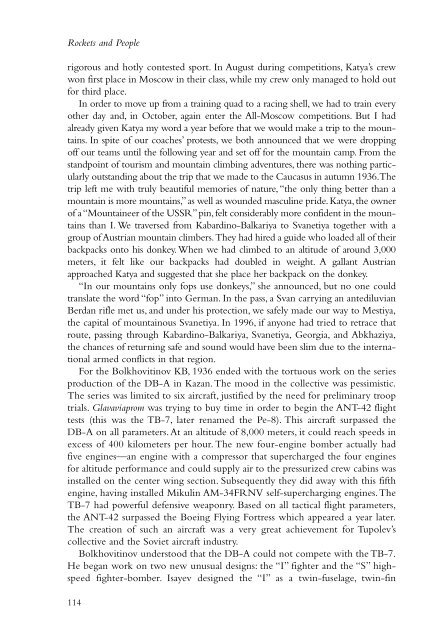to open next chapter. - NASA's History Office
to open next chapter. - NASA's History Office
to open next chapter. - NASA's History Office
You also want an ePaper? Increase the reach of your titles
YUMPU automatically turns print PDFs into web optimized ePapers that Google loves.
Rockets and People<br />
rigorous and hotly contested sport. In August during competitions, Katya’s crew<br />
won first place in Moscow in their class, while my crew only managed <strong>to</strong> hold out<br />
for third place.<br />
In order <strong>to</strong> move up from a training quad <strong>to</strong> a racing shell, we had <strong>to</strong> train every<br />
other day and, in Oc<strong>to</strong>ber, again enter the All-Moscow competitions. But I had<br />
already given Katya my word a year before that we would make a trip <strong>to</strong> the mountains.<br />
In spite of our coaches’ protests, we both announced that we were dropping<br />
off our teams until the following year and set off for the mountain camp. From the<br />
standpoint of <strong>to</strong>urism and mountain climbing adventures, there was nothing particularly<br />
outstanding about the trip that we made <strong>to</strong> the Caucasus in autumn 1936.The<br />
trip left me with truly beautiful memories of nature, “the only thing better than a<br />
mountain is more mountains,” as well as wounded masculine pride. Katya, the owner<br />
of a “Mountaineer of the USSR”pin,felt considerably more confident in the mountains<br />
than I. We traversed from Kabardino-Balkariya <strong>to</strong> Svanetiya <strong>to</strong>gether with a<br />
group of Austrian mountain climbers.They had hired a guide who loaded all of their<br />
backpacks on<strong>to</strong> his donkey.When we had climbed <strong>to</strong> an altitude of around 3,000<br />
meters, it felt like our backpacks had doubled in weight. A gallant Austrian<br />
approached Katya and suggested that she place her backpack on the donkey.<br />
“In our mountains only fops use donkeys,” she announced, but no one could<br />
translate the word “fop” in<strong>to</strong> German. In the pass, a Svan carrying an antediluvian<br />
Berdan rifle met us, and under his protection, we safely made our way <strong>to</strong> Mestiya,<br />
the capital of mountainous Svanetiya. In 1996, if anyone had tried <strong>to</strong> retrace that<br />
route, passing through Kabardino-Balkariya, Svanetiya, Georgia, and Abkhaziya,<br />
the chances of returning safe and sound would have been slim due <strong>to</strong> the international<br />
armed conflicts in that region.<br />
For the Bolkhovitinov KB, 1936 ended with the <strong>to</strong>rtuous work on the series<br />
production of the DB-A in Kazan.The mood in the collective was pessimistic.<br />
The series was limited <strong>to</strong> six aircraft, justified by the need for preliminary troop<br />
trials. Glavaviaprom was trying <strong>to</strong> buy time in order <strong>to</strong> begin the ANT-42 flight<br />
tests (this was the TB-7, later renamed the Pe-8). This aircraft surpassed the<br />
DB-A on all parameters.At an altitude of 8,000 meters, it could reach speeds in<br />
excess of 400 kilometers per hour. The new four-engine bomber actually had<br />
five engines—an engine with a compressor that supercharged the four engines<br />
for altitude performance and could supply air <strong>to</strong> the pressurized crew cabins was<br />
installed on the center wing section. Subsequently they did away with this fifth<br />
engine, having installed Mikulin AM-34FRNV self-supercharging engines.The<br />
TB-7 had powerful defensive weaponry. Based on all tactical flight parameters,<br />
the ANT-42 surpassed the Boeing Flying Fortress which appeared a year later.<br />
The creation of such an aircraft was a very great achievement for Tupolev’s<br />
collective and the Soviet aircraft industry.<br />
Bolkhovitinov unders<strong>to</strong>od that the DB-A could not compete with the TB-7.<br />
He began work on two new unusual designs: the “I” fighter and the “S” highspeed<br />
fighter-bomber. Isayev designed the “I” as a twin-fuselage, twin-fin<br />
114
















